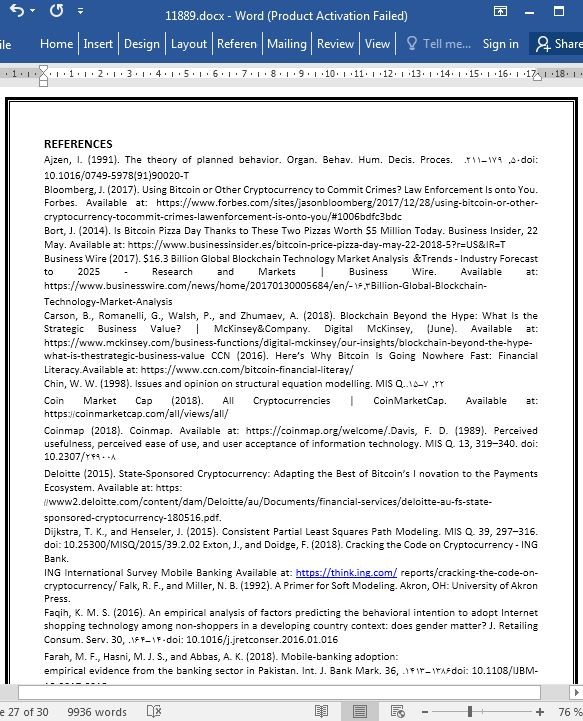
متغیرهای تاثیرگذار بر استفاده از ارز رمزی (کریپتوکارنسی)
رمزی درست همانطور که اینترنت نحوه ارتباطات ما را متحول ساخته، در نحوه انجام معاملات تحولات چشمگیری ایجاد خواهد کرد. در حال حاضر بیش از 2،000 ارز رمزی در بازار عرضه میشوند، و بسیاری موارد دیگر در عرضه اولیه سکه برای استفاده به عنوان یک روش مبادله در یک اکوسیستم تجاری خاص و یا به عنوان حقوق داراییها یا بدهیها، وارد بازار میشوند. ارزهای رمزی به عنوان یک فن آوری مالی نوظهور، فرصتهای زیادی را ایجاد میکنند، اما ممکن است چالشها و محدودیتهای قابل توجهی را نیز بوجود آورند. این مقاله، عوامل اصلی توسعه موفقیت آمیز یک ارز رمزی را از دیدگاه رفتار مصرف کننده مورد تجزیه و تحلیل قرار میدهد. ما با استفاده از یک چارچوب نظری پذیرش فن آوری، مدلی را بررسی میکنیم كه تقریباً میتواند 85٪ از موارد قصد استفاده از ارزهای رمزی را توضیح دهد. با کمال تعجب، ریسک عامل مهمی نبود. این امر ممکن است به این دلیل باشد که بیشتر پاسخ دهندگان استفاده از ارزهای رمزی را پرمخاطره میدانند. عدم تغییرپذیری در پاسخ آنها به سؤالات در مورد ریسک ادراک شده، میتواند توضیحی برای این عدم وجود قدرت تبیین باشد. با این حال، تمایل به مدیریت خطر ارز رمزی میتواند یک پیش شرط برای پذیرش آن باشد. پیش بینی عملکرد برای یک ارز رمزی معین، مهمترین عامل موفقیت آن بود. این تحقیق در اسپانیا بر روی افراد دارای تحصیلات دانشگاهی که از دانش پایه اینترنت برخوردار بودند انجام شد.
بحث و نتیجه گیری
این تحقیق به دنبال بررسی یک مدل توضیحی از قصد استفاده از فن آوری جدید مالی یعنی ارزهای رمزی مبتنی بر بلاکچین بوده است. مدل ارائه شده بر مبنای متغیرهای مدلهای پذیرش فن آوری UTAUT میباشد. ریسک ادراک شده و سواد مالی نیز به عنوان متغیرهای خاص مورد استفاده در تجزیه و تحلیل پذیرش فن آوری مالی افزوده شدند. مدل پیشنهادی 84.8٪ واریانس را در قصد استفاده توضیح میدهد.
نتایج حاکی از آن است که متغیرهایی که بیشترین قدرت تبیین برای قصد یک سرمایه گذار برای استفاده از ارزهای رمزی را دارند، عبارتند از امید به عملکرد ( 68.45% از واریانس توضیح داده شده برای قصد استفاده) و شرایط تسهیل کننده (14.81%). امید به تلاش نیز دارای قدرت تبیین قابل توجهی بود، اما تأثیر کمتری داشت (4.99%). بقیه متغیرها (نفوذ اجتماعی، ریسک ادراک شده و سواد مالی) تأثیر قابل توجهی نداشتند (مقدار احتمال >0.1).
The first commercial transaction with the first cryptocurrency in 2010 marked the start of a revolution in transactions. Blockchain and cryptocurrencies will dramatically transform how we do transactions, just as the Internet revolutionized how we communicate. Currently, more than 2,000 cryptocurrencies are quoted on the market, and many more are being launched in initial coin offerings for use as an exchange method in a specific business ecosystem or as rights to assets or liabilities. As an emerging fintech, cryptocurrencies open up many opportunities, but they also pose significant challenges and limitations. This paper analyzes the key factors for the successful development of a cryptocurrency from a consumer-behavior perspective. Using a technology acceptance theoretical framework, we test a model able to explain almost 85% of the intention to use cryptocurrencies. Surprisingly, risk was not a significant factor. This could be because most of the respondents considered operating with cryptocurrencies to be risky; the lack of variability in their responses to the questions about perceived risk would explain this lack of explanatory power. However, willingness to manage cryptocurrency risk could be a precondition for adoption. The performance expectancy for a given cryptocurrency was the most important factor for its success. The research was conducted in Spain with college-educated adults with basic knowledge of the Internet.
DISCUSSION AND CONCLUSION
This research sought to test an explanatory model of the intention to use a new financial technology, namely, blockchain-based cryptocurrencies. The proposed model was based on variables from UTAUT technology acceptance models. Perceived risk and financial literacy were also added, as variables specifically used in the analysis of fintech acceptance. The proposed model explains 84.8% of the variance in the intention to use.
The results indicate that the variables with the greatest explanatory power for an individual investor’s intention to use cryptocurrencies are performance expectancy (explained 68.45% of the variance in the intention to use) and facilitating conditions (14.81%). Effort expectancy also had significant explanatory power, but the influence was smaller (4.99%). The remaining variables (social influence, perceived risk, and financial literacy) did not have a significant influence (p-value > 0.1).
مقدمه
مروری بر مقالات
موضوعات و روشها
جمع آوری دادهها
مقیاسهای اندازه گیری
مشخصات نمونه
متدولوژی آماری
نتایج
تحلیل مدل اندازه گیری
مدل توضیحی قصد استفاده از ارزهای رمزی (تحلیل مدل ساختاری)
بحث و نتیجه گیری
منابع
INTRODUCTION
LITERATURE REVIEW
MATERIALS AND METHODS
Data Collection
Measurement Scales
Sample Profile
Statistical Methodology
RESULTS
Analysis of the Measurement Model
Explanatory Model of the Intention to Use Cryptocurrencies (Structural Model Analysis)
DISCUSSION AND CONCLUSION
REFERENCES
- اصل مقاله انگلیسی با فرمت ورد (word) با قابلیت ویرایش
- ترجمه فارسی مقاله با فرمت ورد (word) با قابلیت ویرایش، بدون آرم سایت ای ترجمه
- ترجمه فارسی مقاله با فرمت pdf، بدون آرم سایت ای ترجمه



